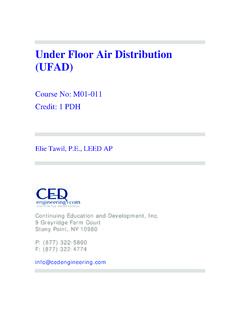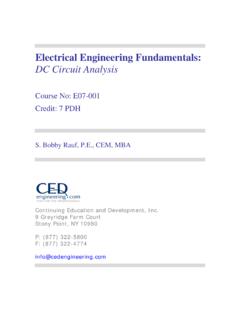Transcription of Design Options for HVAC Distribution Systems
1 Design Options for HVAC Distribution Systems Course No: M06-017 Credit: 6 PDH A. Bhatia Continuing Education and Development, Stonewall CourtWoodcliff Lake, NJ 07677P: (877) Options for HVAC Distribution Systems Overview The objective of an HVAC (heating, ventilating, and air-conditioning) system is to control the temperature, humidity, air movement, and air cleanliness, normally with mechanical means, to achieve thermal comfort. Centralized HVAC system installations utilize a number of separate components that are field assembled to serve the specific needs of an individual building. A central plant has 4 principle elements: 1. Energy Supply ( electricity, fuel); 2. Service Generators ( boilers, chillers); 3. Distribution Components ( air Distribution ducts, pipes); 4.
2 Delivery Components ( diffusers, radiators). Distribution components convey a heating or cooling medium from source-located service generators to portions of a building that require conditioning. Delivery components serve as an interface between the Distribution system and occupied spaces. In this course we will focus on the various Design Options pertaining to cooling and heating air Distribution (item numbers 3 and 4 above). HVAC Systems are of great importance to architectural Design efforts for three main reasons. 1. These Systems consume substantial floor space and/or building volume for equipment and Distribution elements that must be accommodated during the Design process. 2. HVAC Systems constitute a single major budget item in building projects. 3. The success of a building depends on the ability to provide thermal comfort with the least operating costs (maintenance, energy, or replacement).
3 This depends on the HVAC system Design , equipment and controls. There are several choices for air Distribution , each satisfying the HVAC objectives with different degrees of success. The best Design will consider the pertinent architectural and financial constraints without sacrificing the performance in terms of reliability, indoor air quality, and energy efficiency. While HVAC system Design is the responsibility of the HVAC designer, an architect must oversee the complete building project on a wider perspective. The type of system selected is determined by the HVAC designer's knowledge of Systems . The Architect must also understand the basics, system objectives, the role of key system components, the type of Systems that are available and, what such Systems can and cannot accomplish. In selecting a suitable air conditioning system for a particular application, considerations are given to the following: 1.
4 Architectural Constraints: Details of architecture and building construction; Floor space and clear heights to accommodate HVAC equipment and Distribution elements; Aesthetics; Size and appearance of terminal devices; Coordination of reflected ceiling plans with lighting, fire sprinklers/detectors; Acceptable noise levels; Space available to house equipment and its location relative to the conditioned space; Shaft spaces available for routing ducts/pipes, etc. Climate and shading; Indoor and outdoor equipment preferences; Acceptability of components projecting into the conditioned space; Codes and standards of smoke removal Systems ; Usage patterns; Occupancy. 1. System constraints: Type of facility and the indoor conditions required; cooling /heating load; Zoning requirements; Humidification/dehumidification needs; Energy availability and efficiency; Redundancy and equipment configuration; Type of equipment; Reliability of operations; Control scheme; Zone/individual control.
5 3. Financial Constraints Capital cost; Operating cost; Maintenance cost; Replacement costs; Upgrading costs; Equipment failure costs; Return of investment (ROI)/Life cycle analysis. Each of these concerns has a different priority depending on the customer s goals. Most customers may not understand HVAC Design aspects nor their benefits and limitations. It is the responsibility of the Architect and the HVAC Engineer to guide and advise the customer on the best option. For an HVAC Engineer, the customer may be an Architect whose customer may be the building owner. HVAC Distribution Systems Based on the fluid media used in the thermal Distribution system, air conditioning Systems can be classified as: Centralized Systems All Air Systems (significant ducting) Air-Water Systems (moderate ducting) All Water Systems (ductless Systems ) Unitary refrigerant based Systems (usually for smaller applications) Terminal units Fan-coils Inductors Radiators Diffusers Individual (unitary air-conditioning) Systems Compact Split Heat pumps Within the above, there are considerable variations.
6 A building may employ a hybrid combination of these to best satisfy the overall functional objectives. While there are many Options , most conventional centralized Systems fall within one of the following three categories: All-Air System, All-Water System, or Air-Water System. All-Air Systems deliver heated/cooled air to each space through ducts; All-Water Systems deliver chilled/hot water to each space and rely on indoor terminal units; Air-Water Systems deliver a combination of heated/cooled air and hot/chilled water to control aspects of comfort. The obvious difference between the above Systems is the fluid that is used to heat/cool a space: air for All-Air, water for All-Water, and air and water for Air-Water. Why are there so many variations in system Design ? An air conditioning system may have several requirements that must be accommodated during the Design process: 1.
7 The cooling , heating, and moisture control provides the foundation for key HVAC system Design and components; 2. The additional functions of air circulation and air quality control establish further component requirements; 3. In specific building situations, supplemental functions such as noise and smoke control and the interlocking of security and fire protection functions, can be imposed on an HVAC system; 4. Automation and control of an HVAC system is critical to its successful operation. The subject of system control leads to the concept of HVAC zoning. During the Design process, a zone is defined as a region of a building that requires separate control if comfort is to be provided for occupants. Numerous air Distribution Systems are available ranging from uni-zone Systems (the indoor space constitutes a unique conditioned zone), to multi-zone Systems (separate specifically conditioned indoor spaces), with or without reheat Design Options .
8 5. An air conditioning system must satisfy both humidity and temperature requirements. Humidity control generally takes precedence over temperature control and as such, the air is cooled much lower (equal to the apparatus dewpoint of the coil) to remove moisture over the coil surface. The resultant air becomes too cold and is reheated before it is delivered to the indoor spaces. 6. The modern HVAC Design relies on energy efficient variable air volume (VAV) Systems and variable air volume and temperature (VVT) Systems . Many other Options are highlighted in the course. PART 1 ALL - AIR Systems As the name implies, in an all air system air is used as the media that transports energy from the conditioned space to the A/C plant. In these Systems air is processed in the A/C plant and this processed air is then conveyed to the conditioned space through insulated ducts using blowers and fans.
9 This air extracts (or supplies in case of winter) the required amount of sensible and latent heat from the conditioned space. The return air from the conditioned space is conveyed back to the plant, where it again undergoes the required processing thus completing the cycle. No additional processing of air is required in the conditioned space. The system is categorized by the use of air-handling units (AHU) or roof top packages (RTP) to condition air. The conditioned air is sent through ductwork to the occupied space where it will heat or cool the space as required, and return via return air ducts back to the AHU or RTP. Air Handling Units contain a cooling coil (connected to a chiller or condensing unit), a heating coil (connected to boilers or electric heaters), filters, and one or more circulating fans.
10 Roof Top Packages contain a refrigerant cooling cycle, heating coils (connected to boilers or electric heaters), filters, and one or more circulating fans. A schematic arrangement of an All-Air system with its major components is shown below. All-air Systems require the majority of air supplied to a space be returned to the air-handling unit for reconditioning, or exhausted from the building. This "return" air may be conveyed in a return air duct system or through plenums formed by various elements of a building, such as a suspended ceiling or the building structure. All-Air Systems are classified by two main categories: 1. Single duct; 2. Dual or double duct. The single duct Systems can provide either cooling or heating using the same duct, but not both heating and cooling simultaneously.









